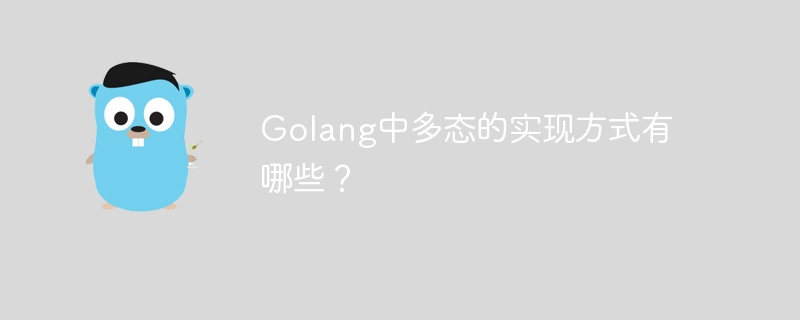

What are the implementation methods of polymorphism in Golang?
Polymorphism is an important concept in object-oriented programming, which means that the same method can be called by different objects, and depending on the object, the specific implementation of the method will be different. In Golang, although there is no inheritance mechanism like other object-oriented languages, polymorphism can be achieved through the combination of interfaces and structures.
In Golang, an interface is an abstract type that can define a set of methods without specifying a specific implementation. Polymorphism can be achieved by defining an interface and letting different structures implement the methods of the interface. The following is a simple example:
type Animal interface {
Speak() string
}
type Dog struct{}
func (d Dog) Speak() string {
return "汪汪汪"
}
type Cat struct{}
func (c Cat) Speak() string {
return "喵喵喵"
}
func main() {
animals := []Animal{Dog{}, Cat{}}
for _, animal := range animals {
fmt.Println(animal.Speak())
}
}In the above code, an Animal interface is defined, including the Speak method. Then the Dog and Cat structures are defined, and the Speak method is implemented for them respectively. In the main function, Dog and Cat are stored in the slice as Animal type elements, and polymorphism is implemented by calling the Speak method in a loop. The result prints out "woof woof woof" and "meow meow meow".
Another way to achieve polymorphism is through the fields of a structure. In Golang, you can use the empty interface{} type to save different types of values. Polymorphism can be achieved by assigning different structures to fields of empty interface{} type. The following is an example:
type Shape interface {
Area() float64
}
type Circle struct {
radius float64
}
func (c Circle) Area() float64 {
return math.Pi * c.radius * c.radius
}
type Rectangle struct {
length float64
width float64
}
func (r Rectangle) Area() float64 {
return r.length * r.width
}
func main() {
shapes := []Shape{Circle{radius: 2}, Rectangle{length: 3, width: 4}}
for _, shape := range shapes {
fmt.Println(shape.Area())
}
}In the above code, a Shape interface is defined, including the Area method. Then the Circle and Rectangle structures are defined, and the Area methods are implemented for them respectively. In the main function, assign the Circle and Rectangle structures to Shape type elements and store them in the slice, and implement polymorphism by calling the Area method in a loop. The results print out the area of the circle and the area of the rectangle.
Summary:
Although there is no inheritance mechanism in Golang, polymorphism can be achieved through the combination of interfaces and structures. Polymorphic calling of methods can be achieved by defining an interface and letting different structures implement the methods of the interface, or by using fields of empty interface{} type to store different types of values. This polymorphic implementation gives Golang the characteristics of object-oriented programming, making the code more flexible and scalable.
The above is the detailed content of What methods are there to achieve polymorphism in Golang?. For more information, please follow other related articles on the PHP Chinese website!




